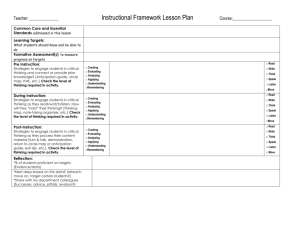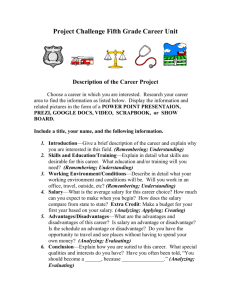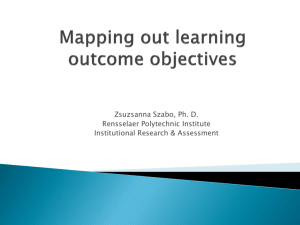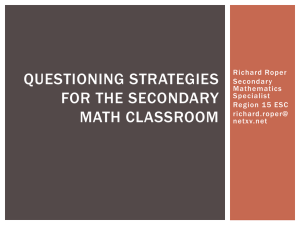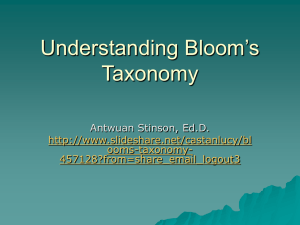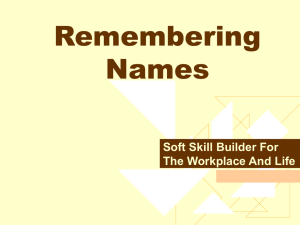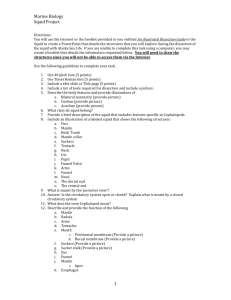PowerPoint Presentation - This is the test page for HTML
advertisement
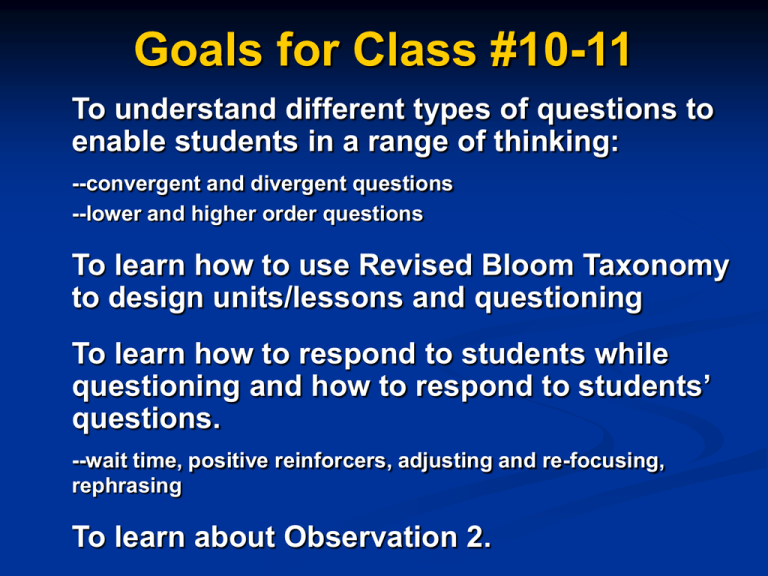
Goals for Class #10-11 To understand different types of questions to enable students in a range of thinking: --convergent and divergent questions --lower and higher order questions To learn how to use Revised Bloom Taxonomy to design units/lessons and questioning To learn how to respond to students while questioning and how to respond to students’ questions. --wait time, positive reinforcers, adjusting and re-focusing, rephrasing To learn about Observation 2. Review - RIBTS Standard 9 1. 2. 3. 4. 5. Distinguish: assessment for student learning and assessment of student learning. What are five steps that represent the process of assessing student learning? What are two internal and two external sources of assessment information? Present an example of a set of questions you could use to pre-assess learners while using a KWAL during your unit? Describe a type of assessment you could use as a learner self-assessment you could use during make it and take it. RIBTS Standard 5 CRITICAL THINKING AND PROBLEM SOLVING Standard 5 Concepts of Teaching 5.1 Designing lessons with higher order thinking Revised Bloom’s Taxonomy Convergent and Divergent Questions 5.2 Posing questions to enable students to think in different ways Revised Bloom’s Taxonomy Convergent and Divergent Questions Interactive Models of Teaching Direct Instruction, Inquiry, Presentation, Concept Teaching, Integrative (Taba) Model 5.3 Knowing when to present, clarify, pose a question, let a student struggle Questioning and Responding Handling Students Questions Formative Assessment 5.4 Engaging students in inquiry Inquiry or PBL Interactive Model of Teaching 5.5 Using activities, materials, and student products to engage students in exploration, discovery, and hands on activities Three Approaches to Learning Hands on,multi-sensory (real materials and phenomena) Pictorial graphic organizers, photographs, diagrams, graphs) Symbolic (printed and electronic text) Link to RIBTS Standard 5 CRITICAL THINKING AND PROBLEM SOLVING Teachers create instructional opportunities to encourage students’ development of critical thinking, problem solving, and performance skills. Teachers... 5.1 design lessons that extend beyond factual recall and challenge students to develop higher-level cognitive skills. 5.2 pose questions that encourage students to view, analyze, and interpret ideas from multiple perspectives. 5.3 make instructional decisions about when to provide information, when to clarify, when to pose a question, and when to let a student struggle to try to solve a problem. 5.4 engage students in generating knowledge, testing hypotheses, and exploring methods of inquiry and standards of evidence. 5.5 use tasks that engage students in exploration, discovery, and hands-on activities. The Art and Science of Questioning An essential skill for interactive teaching and learning The Making of a Scientist: Richard Feynman I don't have to know an answer. I don't feel frightened by not knowing things, By being lost in the mysterious universe Without having any purpose, Which is the way it really is, As far as I can tell, Possibly. It doesn't frighten me. -Richard Feynman I learned very early the difference between knowing the name of something and know something. -Richard Feynman Why Is Questioning Important? CAUSES LEARNERS TO EXAMPLE OF QUESTIONS Think in different ways Convergent (one answer) Which has eight appendages--and octopus or squid? Divergent (many possible answers) If you were an aquarium director, which cephalopod would you place in the aquarium? Explain your reasons. Test their own ideas Observe the squid: Are there eight arms or ten arms? Transfer their ideas from one situation to another How can you use the same procedure to print a fish? Discuss words they use to describe their ideas What does the word “cephalopod” mean? What is the “pod” of the squid? Extend the range of evidence available to learners How does a squid move like a inflated balloon that is released? Explain their ideas How does a octopus defend itself from predators? Research indicates that questioning is valuable in enabling students to think in different ways and to develop ways of learning. - Larry Lowery The art of raising challenging questions is easily as important as the art of giving clear answers. -Jerome Bruner True dialogue occurs when teachers ask questions to which they do not presume to already know the correct answer. -J. Lemke Blosser’s Types of Questions Closed Open (Convergent) (Divergent) -To pre-assess -To promote discussion or student interaction -To cause students to think in different ways -To assess retention of information -To focus thinking on a particular point Blosser’s Types of Questions Managerial Rhetorical To keep the classroom operations moving To emphasize a point or reinforce an idea or statement --Will you turn to page 115, please? --The squid has ten appendages, right? --At the last class, I taught the interactive teaching model called direct instruction, right? --Who needs more time to finish the drawing? The nature of each question shapes one’s response to it. Revised Bloom’s Taxonomy is used to plan effective questioning. Cognitive Processes: Creating Evaluating Analyzing Applying Understanding Remembering About Revised Bloom’s Taxonomy What is RBT? A classification of different ways of thinking Ways of thinking ranked from lower to higher order. When was RBT developed? Developed in the 1956 by Benjamin Bloom. For six years in 1990’s Lorin Anderson (former student of Bloom) revisited the taxonomy and made changes. Original Terms New Terms Evaluation •Creating Synthesis •Evaluating Analysis Application Comprehension Knowledge •Analyzing •Applying •Understanding •Remembering RBT Cognitive Processes With Knowledge Dimension COGNITIVE PROCESSES DIMENSION KNOWLEDGE DIMENSION Remember Factual Knowledge List Understand Summarize Conceptual Describe Interpret Knowledge Apply Analyze Evaluate Create Classify Order Rank Combine Experiment Explain Assess Plan Calculate Differentiate Conclude Compose Action Actualize Procedural Knowledge Tabulate Predict MetaCognitive Knowledge Appropriate Use Execute Construct Achieve http://projects.coe.uga.edu/epltt/index.php?title=Bloom%27s_Taxonomy About Revised Bloom’s Taxonomy Who uses RBT and why is used? Administrators use RBT for curriculum planning. Teachers use RBT for planning instruction: To improve questioning and student thinking To plan and guide learners through a learning experience Planning unit goals and lesson objectives Designing different types of assessment Creating activities Questioning during instruction Remembering The learner is able to remember information. Remembering Recognizing Recalling KNOWLEDGE DIMENSION VERB Factual Knowledge List Conceptual Knowledge Describe Procedural Knowledge Tabulate •Creating •Evaluating Meta-Cognitive Appropriate Use Knowledge •Analyzing •Applying •Understanding •Remembering Remembering List Memorize • Group Relate • Listen Show Locate • Choose Distinguish • Recite Give example • Review Reproduce • Quote Quote • Record Repeat Label • Match Recall • Select Know • Underline Group • Cite Read Write • Sort Outline Recall or recognition of specific information Products include: • Quiz or Test • Fact Cards • Worksheet • Recitations • Label Diagram • Crossword Puzzle • Workbook • Jeopardy Remembering Activities and Products Make a story map showing sequence of the main events. Make a concept map of the topic. Write a different fact on each 3x5 fact card. List three steps of experiment procedure. Draw the external structure and label the parts you remember. •Creating Memorize and recite the poem. •Evaluating Complete the crossword puzzle. •Analyzing •Applying •Understanding •Remembering Understanding The learner explains the information or concepts. Interpreting Exemplifying Summarizing Inferring Paraphrasing Classifying Comparing Explaining KNOWLEDGE DIMENSION VERB Factual Knowledge Summarize Conceptual Knowledge Interpret Procedural Knowledge Predict •Creating Meta-Cognitive Execute Knowledge •Evaluating •Analyzing •Applying •Understanding •Remembering Understanding Restate Identify • • Discuss • Retell • Research • Annotate • Translate • Give examples• Paraphrase • Reorganize • Associate • Describe Understanding Report of given information Recognize Review Observe Outline Products include: Account for • Drawing • Summary Interpret • Paraphrasing • Story Problems Give main idea • Peer Teaching Estimate • Show and Tell Define in own words Understanding Activities and Products Write in your own words… Cut out, or draw pictures to illustrate a particular event in the story. Report to the class… Illustrate what you think the main idea may have been. Make a cartoon strip showing the sequence of events in the story. Write a brief outline to explain this experiment to someone else. Explain why the character solved the problem in this particular way. Write a summary report of the experiment. •Creating Prepare a flow chart to illustrate the steps •Evaluating you used to solve the problem. •Analyzing Paraphrase this chapter in the book. Retell in your own words. •Applying Outline the main points. •Understanding •Remembering Applying The learner makes use of information in new ways, in a context different from the one in which it was learned. Implementing Carrying out Using Executing KNOWLEDGE DIMENSION VERB Factual Knowledge Classify Conceptual Knowledge Experiment Procedural Knowledge Calculate Meta-Cognitive Knowledge Construct •Creating •Evaluating •Analyzing •Applying •Understanding •Remembering Applying Translate Manipulate Exhibit Illustrate Calculate Interpret Make Practice Apply Operate Interview • • • • • • • • • • • • • Paint Change Compute Sequence Show Solve Collect Demonstrate Dramatize Construct Use Adapt Draw Using strategies, concepts, principles and theories in new situations Products include: • Photograph • Presentation • Role Playing • Interview • Simulation • Performance • Model Building • Diary or Journal • Demonstration • Scrapbook Applying Activities and Products Use the balloon to show how the squid uses jet propulsion Make a diorama to illustrate how an octopus uses camouflage to defend itself from it’s predator Write a diary entry Make a scrapbook about the area of study Make a paper airplane that turns to the right Take and display a collection of photographs on a particular topic Make up a puzzle or a game about the topic Write an explanation about this topic for others Dress a doll in national costume Make a clay model Paint a mural using the same materials Analyzing The learner distinguishes the different parts. Comparing Organizing Deconstructing Attributing Relating parts Differentiating KNOWLEDGE DIMENSION VERB Factual Knowledge Order Conceptual Knowledge Explain Procedural Knowledge Differentiate •Creating •Evaluating Meta-Cognitive Achieve Knowledge •Analyzing •Applying •Understanding •Remembering Analyzing Distinguish Question Appraise Experiment Inspect Examine Probe Separate Inquire Arrange Investigate Sift Research Calculate Criticize • • • • • • • • • • • • • • • Compare Contrast Survey Detect Group Order Sequence Test Debate Analyze Diagram Relate Dissect Categorize Discriminate Breaking information down into its component elements Products include: • Graph • Survey • Spreadsheet • Database • Checklist • Mobile • Chart • Questionnaire • Outline • Report Analyzing Activities and Products Use a Venn Diagram to show how two topics are the same and different Design a questionnaire to gather information. Survey classmates to find out what they think about a particular topic. Analyze the results. Make a flow chart to show the critical stages. Classify the actions of the characters in the book. Make a family tree showing relationships. Write a conclusion that shows show your thinking as changed as a result of experimenting. •Creating Write a list of claims that are supported with •Evaluating evidence Review a work of art in terms of form, color •Analyzing •Applying and texture. Make a chart that shows pros and cons •Understanding •Remembering Evaluating The learner defends a concept or idea, makes decisions based on in-depth reflection, criticism and assessment. Evaluating Checking Critiquing Judging KNOWLEDGE DIMENSION VERB Factual Knowledge Rank Conceptual Knowledge Assess Procedural Knowledge Conclude •Creating •Evaluating Meta-Cognitive Action Knowledge •Analyzing •Applying •Understanding •Remembering Evaluating Judge Rate Validate Predict Assess Score Revise Infer Determine Prioritize Tell why Compare Evaluate Defend Select Measure • • • • • • • • • • • • • • • Choose Conclude Deduce Debate Justify Recommend Discriminate Appraise Value Probe Argue Decide Criticize Rank Reject Judging the value of ideas, materials and methods by developing and applying standards and criteria. Products include: • Debate • Investigation • Panel • Verdict • Letter to Editor • Conclusion • Self-Evaluation •Persuasive speech Evaluating Activities and Products Write a letter to the editor or op-ed column. Prepare and conduct a debate. Prepare a list of criteria to judge. Write a persuasive speech arguing for/against. Make a booklet about five rules you see as important. Convince others. Form a panel to discuss viewpoints. Write a letter to. ..advising on changes needed. Prepare a case to present your view about... Complete a chart that shows benefits, limitations and your conclusion or solution to the problem. Evaluate the character’s actions in the story •Creating •Evaluating •Analyzing •Applying •Understanding •Remembering Creating The learner creates new ideas and information using what has been previously learned. Hypothesizing Generating Planning KNOWLEDGE Producing DIMENSION Factual Inventing VERB Combine Knowledge Conceptual Knowledge Plan Procedural Knowledge Compose •Creating •Evaluating Meta-Cognitive Actualize Knowledge •Analyzing •Applying •Understanding •Remembering Creating Compose Assemble Organize Invent Compile Forecast Devise Propose Construct Plan Prepare Develop Originate Imagine Generate • Formulate • Improve Putting together ideas or elements to develop a original idea or engage in creative thinking. • Act • Predict • Produce • Blend • Set up Products include: • Devise • Puppet Show • Song • Concoct • Story • Newspaper • Skit • Cartoon • Media Product • Advertisement • New game • Book Cover • Compile Creating Activities and Products Invent a machine to do a specific task. Design a comic strip or cartoon using the squid as a character. Create a new product using the theme of squids. Give it a name and plan a marketing campaign. Write a TV show play, puppet show, role play, song or pantomime about.. Develop a newspaper story with these headlines “The Case of the Missing Shark” •Creating Design a record, book or magazine cover •Evaluating •Analyzing •Applying •Understanding •Remembering Strategies for Teaching with Bloom’s Required-Optional Cognitive Process of the Day Work on a level of thinking singled out for particular attention (ANALZYING: comparing and contrasting) Teach learners to use Bloom’s. Label some activities as “required” while others are “optional.” Have learners develop their own activities using the taxonomy. Lower Level First, Then Design a higher level Some learners work through the lower levels and then the learners design their own activities at the higher levels Strategies for Teaching with Bloom’s Lower Level First, Then Higher Lvel Activities Differentiate Instruction. Accommodate Diverse Learners All learners work through the lower level stages and then select at least one activity from each of the higher levels. All learners work through first two levels and then select activities from any other level Some learners work on an activity at a lower level while others work on an activity at higher levels Select Any Activity or Product at any Level: Create a list of activities and products. Learners select activities from any level. Unit Activities for DELICIOUS SQUID Remembering Download squid images from internet. Make a digital photo display or a collage. Complete the squid crossword puzzle. List the names of the cephalopods. Understanding Make a squid puppet for a puppet show. Use it to tell what a day in a life of squid does. Make a model of a squid and show external and internal structures. Applying Demonstrate how a squid moves with a balloon. Keep a diary of a day in the life of a squid (24 hours). What does it do in the morning, noon, and evening. What would it do during the day to survive? What challenges would it face? Analyzing Make a Venn diagram and compare and contrast a squid and an octopus. Evaluating If you were an aquarium director, which would you choose to put in the tank: squid, octopus, cuttlefish, or nautilus. Choose and give reasons. Creating Write a newspaper article based on the following headline: “Missing Dogfish Shark at the New England Aquarium.” Create a board game called “Squi-Dora The Explora”. Questions and Statements Stems for Remembering What happened after...? How many...? What is...? Who was it that...? Name the ...? Find the definition of… Describe what happened after… Who spoke to...? Which is true or false...? •Creating •Evaluating •Analyzing •Applying •Understanding •Remembering Questions and Statements Stems for Understanding Explain why… Write in your own words… How would you explain…? Develop a brief outline...? What do you think could have happened next...? Who do you think...? What was the main idea...? •Creating Can you clarify…? •Evaluating •Analyzing llustrate…? •Applying Does everyone act in the way that.. •Understanding does? •Remembering Questions and Statements Stems for Applying What is another example where…? Group by characteristics such as…? Which factors would you change if…? What questions would you ask of…? From the information given, can you develop a set of instructions about…? •Creating •Evaluating •Analyzing •Applying •Understanding •Remembering Questions and Statements Stems for Analyzing Which events could not have happened? If. ..happened, what might the ending have been? How is...similar to...? What do you see as other possible outcomes? Why did...changes occur? Explain what must have happened when...? What are some or the problems of...? Distinguish between...? •Creating What were some of the motives behind..? •Evaluating What was the turning point? •Analyzing What was the problem with...? •Applying •Understanding •Remembering Questions and Statements Stems for Evaluating Which is the better solution to...? Judge the value of... What do you think about...? Defend your position about...? Decide: Is a good or bad thing? What are your reasons? How would you have handled...? What changes to.. would you recommend? How effective are. ..? What are the consequences..? What influence will....have on our lives? What are the pros and cons of....? •Creating Why is ....of value? •Evaluating What are the alternatives? •Analyzing Who will gain & who will lose? •Applying •Understanding •Remembering Questions and Statements Stems for Creating Design a...to...? Create a possible solution to...? If you had access to all resources, how would you deal with...? Devise your own way to...? What would happen if ...? How many ways can you...? •Creating Create new and unusual uses for...? •Evaluating •Analyzing Develop a proposal which would...? •Applying •Understanding •Remembering First, work learners through lower level questions. Why use these questions? To confirm their knowledge of factual and conceptual knowledge To diagnose their strengths and weaknesses To review and/or summarize knowledge that has been learned •Creating •Evaluating •Analyzing •Applying •Understanding •Remembering Then, move learners to higher level questions. Why? To help them transform information and gain new meaning and to Reflect and think more deeply and critically Problem solve Extend their thinking when you present information, teach a concept, or develop a skill Seek information on their own or think creatively. •Creating •Evaluating •Analyzing •Applying •Understanding •Remembering Putting it all together in Bloom’s Bakery Click on url. Scroll to bottom for the animation. http://projects.coe.uga.edu/epltt/index.p hp?title=Bloom%27s_Taxonomy The layers of the cake represent the levels of learning with each layer representing increasing complexity. All of the levels of the Revised Bloom's Taxonomy come together to form a complete learning experience just as the animation comes together to form a complete cake. Happy 95th Birthday Benjamin Bloom! Born February 21st NOW IT’S YOUR TURN Using Bloom’s Revised Taxonomy, plan instructional objectives, questions/statements and activities that cause students to think in different ways. See Handout. Refer to Arends text, pp. 115, 421-423 Make a Bloom’s Chart for your topic. TOPIC: COGNITIVE PROCESS INSTRUCTIONAL OBJECTIVE Remembering The learners will be able to Understanding The learners will be able to Applying The learners will be able to Analyzing The learners will be able to Evaluating The learners will be able to Creating The learners will be able to QUESTIONS STATEMENTS See Handout. Refer to Arends text, pps. 115, 421-423 ACTIVITY PRODUCT Example - Bloom’s Chart Delicious Squid COGNITIVE PROCESS INSTRUCTIONAL OBJECTIVE QUESTIONS STATEMENTS ACTIVITY PRODUCT Remembering The learners will be able to remember the structures and functions of a squid. Match the structure with the function. Complete the Crossword Puzzle. Understanding The learners will be able to explain how a squid defends itself from its predator. How does a squid defend itself from a predator? Draw a squid and its predator. Write a caption explaining how it will defend itself. Applying The learners will be able to demonstrate how a squid moves using the balloon. How can you demonstrate how a squid moves with a balloon? Use this balloon to demonstrate how a squid moves. Analyzing The learners will be able to compare and contrast a squid an octopus. How is a squid similar and different from an octopus? Make a Venn Diagram comparing and contrasting a squid and octopus. Evaluating The learners will be able to judge which cephalopod is best for the city aquarium. Decide which is best for a city aquarium: Squid, octopus, cuttlefish, or nautilus. Write an opinion letter to the aquarium director advocating for the cephalopod. Creating The learners will be able to create a new species of cephalopod. Create a new species of cephalopod. Using the clay, sculpt a new species. Responding to Students • • • • • • Wait Time Using Positive Reinforcers Using Probes Adjusting and Re-focusing Rephrasing Responding to Students’ Questions Responding to Students Wait Time Teacher Question Pause (wait time 1) Student Response Pause (wait time 2) Teacher Response See Arends, pp. 418-419 Responding to Students Wait Time • • Wait Time I (wait several seconds) Wait Time II (allow other learners to respond after a learner responds) Responding to Students Using Positive Reinforcers • Positively reinforce the student by making positive statements, nodding, smiling, eye contact. Superb! You provided excellent reasons! Wow! You really know your facts! Thanks for sharing your great thinking. Responding to Students Using Probes If a students provide a superficial, incomplete response, use probing questions to cause a student to clarify or extend his or her thinking. Teacher: How does a squid defend itself? Student: A squid uses ink. Teacher: Tell me more. How does a squid use the ink to defend itself. Responding to Students Adjusting or Re-focusing • If a student provides a response that is irrelevant or out of context, ask questions or make statements to cause students to tie response to the topic. Teacher: What are the squid’s predators? Student: It eats shrimp and fish. Teacher: You’re stating what a squid eats. A predator is eats a squid. What predators eat a squid? Responding to Students Adjusting or Re-focusing If a student provides a wrong response, don’t dwell on it. Ask other students to add to the response or provide the right response. What other ideas do you (class) have? or Do you agree or disagree? Explain your thinking. Responding to Students Rephrasing If a student provides a wrong response or no response, don’t tell the student he or she is wrong. Reword the question, ask a lower level questions, and/or provide additional information to guide the student to the right answer. Teacher: How is a squid well adapted? Student: No response. Teacher: An adaptation is a change in an organism that allows it to live successfully in its environment. Think about the squid’s body parts. What are the squid’s body parts? How are the body parts help it live successfully in the open ocean? Responding to Students’ Questions Above all, don’t fake it! If a student asks a question and you don’t know the answer, don’t fake it. Propose a plan to answer the question. Work with the student(s) to identify resources to answer the question. How could we answer this question? Volunteer to find the answer yourself. Sources • • • Arends, R. Learn to Teach. http://www.kurwongbss.qld.edu.au/thinking/Bl oom/blooms.htm http://projects.coe.uga.edu/epltt/index.php?titl e=Bloom%27s_Taxonomy
